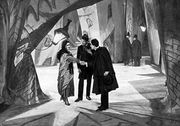The term stems from the theater where, in French, mise en scène means literally "putting into the scene" or "setting in scene." When applied to the cinema, then, mise en scène refers to everything that appears before the camera and its arrangement – sets, props, actors, costumes, and lighting. Mise en scène also includes the positioning and movement of actors on the set, which is called blocking.
This narrow definition of mise en scène is not shared by all critics. For some, it refers to all elements of visual style — that is, both elements on the set and aspects of the camera. For others, such as Andrew Sarris, it takes on mystical meanings related to the emotional tone of a film.
It has also come to represent a style of conveying the information of a scene primarily through a single shot – often accompanied by camera movement. It is to be contrasted with montage-style filmmaking – multiple angles pieced together through editing.
 The distinctive mise en scene of
The Cabinet of Dr. Caligari
The distinctive mise en scene of
The Cabinet of Dr. Caligari
In
German filmmaking in the 1910s and 1920s one can observe
tone, meaning, and narrative information conveyed through
mise en scène. Perhaps the most famous example of this is
The Cabinet of Dr. Caligari (1920) where a
character's internal state of mind is represented through
set design and blocking.
The similar-sounding, but unrelated term, "metteurs en
scène" (literally, "setters of the scene" or
"directors") was used by the
auteur theory to disparagingly label
directors who did not put their personal vision into
their films.
Mise-en-scene is regularly used in modern film to portray the mindset of character(s) in the film.
Only rarely is mise en scène critique used in other art forms, but it has been used effectively to analyze photography, literature and comics.
Mise*En*Scene is also the name of a Belgian punk/ska group.
External links
- The Straight Dope: What do artsy film critics mean by "mise-en-scene"?
- TV Cream's "mise-en-scene" guide.
- Buster Answers: Mise en Scène
Further reading
- Bordwell, David; Thompson, Kristin (2003). Film Art: An Introduction, 7th ed.. New York: McGraw-Hill. ISBN 0072484551. Contains a chapter on mise en scène with a concise definition of it.
Categories: Film theory




 216.73.216.81
216.73.216.81 User Stats:
User Stats:
 Today: 0
Today: 0 Yesterday: 0
Yesterday: 0 This Month: 0
This Month: 0 This Year: 0
This Year: 0 Total Users: 117
Total Users: 117 New Members:
New Members:
 216.73.xxx.xx
216.73.xxx.xx
 Server Time:
Server Time: